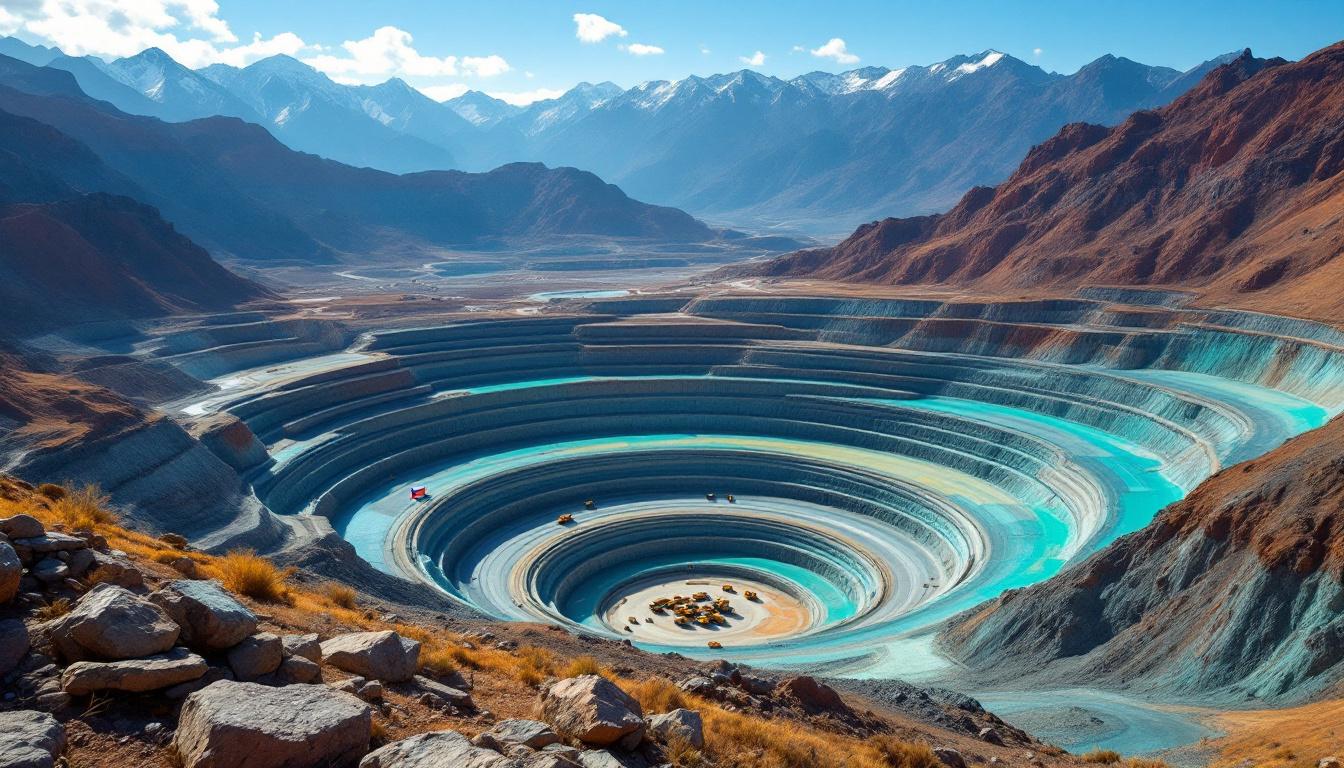How is Australia's Gold and Copper Export Market Evolving?
Australia's resources sector is undergoing significant transformation, with gold and copper emerging as standout performers in an evolving export landscape. While overall resource export revenues are projected to decline moderately through 2027, these two commodities are bucking the trend with impressive growth trajectories.
The nation's mining industry continues to demonstrate remarkable resilience amid global market fluctuations. Gold is cementing its position as a cornerstone of Australia's export economy, while copper's rising prominence reflects its critical role in the energy transition outlook and technological advancement.
According to industry analysts, Australia's competitive advantage in both commodities stems from a combination of high-grade deposits, world-class mining expertise, and strategic government support programs designed to enhance the sector's long-term sustainability.
Geological Advantages Driving Export Growth
Australia's geological endowment provides a natural competitive edge in both gold and copper production. The country hosts some of the world's richest mineral provinces, with Western Australia's Goldfields region and South Australia's Olympic Dam representing world-class mineral systems.
The nation's copper ore grades average 1.6%, significantly higher than the global average of 0.7%, providing substantial cost advantages in production and processing. This geological advantage, combined with decades of mining expertise, positions Australia favorably as global demand intensifies.
What Do the Latest Export Forecasts Reveal?
Key Export Projections Through 2027
The June 2025 Resources and Energy Quarterly (REQ) released by the Department of Industry, Science and Resources paints a nuanced picture of Australia's export outlook. Overall resource export earnings are projected to decline from $385 billion in FY25 to $369 billion in FY26 (a 4.2% decrease) and further to $352 billion in FY27 (an additional 4.6% decline).
Despite this overall revenue reduction, the report highlights that export volumes are expected to increase across several key commodities. This volume growth will continue supporting employment and economic activity throughout Australia's mining regions, even as price moderation affects total earnings.
The contrast between volume growth and revenue decline underscores the complex dynamics at play in global commodity markets, where supply expansions and varying demand patterns create divergent price trajectories across the resource portfolio.
Gold's Rising Prominence in Australia's Export Portfolio
Gold stands out as a particular bright spot, positioned to become Australia's third-largest resources export earner behind only iron ore and liquefied natural gas (LNG). The precious metal's export earnings are forecasted to reach an impressive $56 billion in FY26, representing 15.2% of total resource exports.
While gold prices are expected to moderate slightly in FY27, bringing export values down to $52 billion, they remain historically strong. Australia maintained its position as the world's second-largest gold producer in 2024, with production of 320 tonnes, behind only China's 370 tonnes according to the World Gold Council's Annual Gold Production Report.
The nation's gold sector benefits from both established operations and new project developments. The Cadia Valley Operations in NSW, Australia's largest gold mine, increased production by 8% in 2024-25, contributing significantly to national export volumes. Meanwhile, exploration activity remains robust, with junior miners reporting promising discoveries in both traditional and emerging gold provinces.
Copper's Remarkable Growth Trajectory
Copper exports are projected to experience exceptional growth, increasing by more than 25% to exceed $16.7 billion in FY26. This upward trajectory is expected to continue, with copper export values surpassing $18 billion in FY27, highlighting the metal's growing importance in Australia's export mix.
The copper growth story is fundamentally tied to electrification and the energy transition. Each electric vehicle requires up to four times more copper than conventional vehicles, creating sustained demand growth. Additionally, renewable energy infrastructure is highly copper-intensive, with solar and wind power systems requiring significantly more copper per megawatt than traditional power generation.
BHP's Olympic Dam in South Australia saw copper production rise by 15% in 2024, bolstering the national copper export capacity. The operation's unique polymetallic nature—producing copper, gold, silver, and uranium from a single orebody—exemplifies the integrated nature of Australia's mining advantages.
Why Are These Commodities Experiencing Growth?
Global Market Dynamics Driving Demand
Multiple factors are converging to drive demand for both gold and copper. Gold's traditional role as a safe-haven asset has been reinforced by ongoing global economic uncertainty, geopolitical tensions, and concerns about inflation. Global gold demand increased 7% year-on-year to 4,950 tonnes in 2024, driven primarily by central bank purchases and investment demand.
"Australia's gold sector benefits from both its geological endowment and geopolitical stability, making it a preferred supplier during times of global uncertainty." – World Gold Council Australia Director, Mining Industry Report 2025
Copper's growth trajectory is even more structural in nature. The International Energy Agency projects copper demand for renewable energy technologies to grow at 12.5% annually through 2030. Electric vehicle production grew 35% globally in 2024, requiring approximately 2.8 million tonnes of copper. This electrification trend represents a fundamental shift in copper's demand profile, moving beyond traditional construction and manufacturing applications.
Australia's Competitive Position in Global Markets
Despite softening commodity prices across some sectors, Australian mining companies are maintaining strong competitive positions in international markets. The country's reputation as a reliable supplier of resources and energy continues to be a significant advantage during periods of global uncertainty.
Federal Resources and Northern Australia Minister Madeleine King highlighted this advantage, noting: "The latest Resources and Energy Quarterly underlines how Australia remains a trusted and reliable supplier of resources and energy to the world at a time of ongoing global uncertainty."
Technological innovations in gold processing have reduced recovery costs by approximately 12% since 2022, improving export competitiveness. Similarly, automation and digital technologies are enhancing productivity across Australia's copper operations, with remote operations centers and predictive maintenance systems reducing operational costs.
How Does This Compare to Other Resource Sectors?
Iron Ore, Coal, and LNG Facing Headwinds
While gold and copper show promising growth, traditional powerhouse commodities are experiencing challenges. Iron ore export values are projected to decline by 8% in FY26 despite volume growth of 3%, due to price softening. Similarly, coal export earnings are expected to fall by 12% in FY26 as global energy transitions accelerate.
LNG exports, while remaining substantial, are also facing price pressures. The combined effect of these declines would be more pronounced if not for the counterbalancing growth in gold, copper, and other critical minerals.
This divergence highlights the changing nature of global commodity markets, where decarbonization efforts are creating structural shifts in demand patterns. As Federal Resources Minister Madeleine King noted: "Higher prices for gold, and forecast higher copper price forecast and lithium exports, are partly offsetting the impact of lower prices for iron ore, coal and LNG."
Lithium's Recovery from Market Softness
Lithium, another critical mineral, is showing signs of market recovery after a period of oversupply and price weakness. Export earnings for lithium are projected to increase from $4.6 billion in FY25 to over $6.6 billion by FY27, representing impressive 43% growth over the period.
This recovery reflects lithium's essential role in battery technologies, particularly for electric vehicles and grid-scale energy storage. Australia has established itself as the world's largest lithium producer, with substantial hard-rock spodumene operations primarily located in Western Australia.
The following table illustrates the contrasting trajectories of Australia's key mineral exports:
| Commodity | FY25 Earnings | FY26 Projection | FY27 Projection | Growth Trend |
|---|---|---|---|---|
| Gold | ~$51 billion* | $56 billion | $52 billion | Growth, then slight moderation |
| Copper | ~$13.4 billion* | $16.7+ billion | $18+ billion | Consistent strong growth |
| Lithium | $4.6 billion | ~$5.6 billion* | $6.6+ billion | Steady recovery |
| Iron Ore | ~$102 billion* | ~$94 billion* | ~$88 billion* | Declining despite volume growth |
| Coal | ~$58 billion* | ~$51 billion* | ~$47 billion* | Structural decline |
| Total Resources | $385 billion | $369 billion | $352 billion | Moderate decline |
*Estimated based on percentage growth/decline projections
What Government Initiatives Support These Export Sectors?
Strategic Investments in Resource Development
The Australian Government has implemented several initiatives to support the resources sector, with the $3.4 billion Resourcing Australia's Prosperity initiative standing as a cornerstone program. This initiative provides essential geoscience research and data that underpin exploration and development activities across the mining industry.
The program includes funding for advanced 3D geological mapping using cutting-edge seismic technologies to identify new mineral deposits. These pre-competitive datasets reduce exploration risk and encourage investment, particularly in frontier or underexplored regions with potential for new discoveries.
Additionally, $2.1 billion in research grants for mining technology innovation have been approved since 2023, supporting collaborative projects between industry, universities, and research organizations. These investments aim to enhance productivity, sustainability, and safety across the mining value chain.
Critical Minerals Production Tax Credits
A $7 billion package of production tax credits has been legislated to strengthen domestic critical minerals processing capabilities. This initiative aims to enhance Australia's position in global supply chains while supporting the worldwide transition to net-zero emissions by 2050.
The Critical Minerals Production Tax Credit provides a 10% refundable tax offset for eligible processing activities, with higher rates available for advanced manufacturing applications. This incentive structure is designed to encourage the development of downstream processing and value-adding activities within Australia, rather than simply exporting raw materials.
Minister Madeleine King emphasized the strategic importance of these programs: "The Australian Government continues to support our resources and energy sectors. We have invested $3.4 billion in the Resourcing Australia's Prosperity initiative to provide the geoscience that is foundational to our resources sector."
What Are the Economic Implications of These Export Trends?
Job Creation and Regional Development
The projected increase in export volumes, particularly for gold and copper, is expected to support continued employment opportunities in the Australian mining sector. The mining industry directly employed 271,000 Australians in 2024, with gold and copper operations accounting for 17% of this workforce.
Regional communities with significant mining operations show tangible economic benefits from this activity. According to the Regional Australia Institute, mining regions demonstrated 3.2% higher average income compared to non-mining regions in 2025. The town of Kalgoorlie-Boulder in Western Australia saw population growth of 2.8% in 2024, compared to the national average of 1.3%, driven by gold mining expansion.
Beyond direct employment, the mining equipment, technology and services (METS) sector generated $97 billion in revenue in 2024, supporting an additional 200,000+ jobs throughout the supply chain. This multiplier effect amplifies the economic impact of mining activity across the broader economy.
Balancing Revenue Fluctuations Across Commodities
The diversification of Australia's resource export portfolio helps mitigate risks associated with price volatility in any single commodity. The strong performance of gold and copper provides a valuable counterbalance to declining prices in other resource categories.
This portfolio approach to resource development has become increasingly important as traditional commodities face structural challenges from decarbonization efforts. As noted by the Reserve Bank of Australia in its 2025 Mining Industry Analysis: "The diversification of Australia's mineral export portfolio has become increasingly important as traditional commodities face structural challenges from decarbonization efforts."
Australia's mining royalties system ensures that communities benefit from export growth, with approximately $18.7 billion in royalties collected in 2024 supporting public services. This revenue stream represents a critical contribution to state budgets, particularly in Western Australia, Queensland, and New South Wales.
FAQ: Australia's Gold and Copper Export Outlook
How significant is gold to Australia's export economy?
Gold is set to become Australia's third-largest resource export earner behind iron ore and LNG, with projected earnings of $56 billion in FY26, representing 15.2% of total resource exports. The sector directly employs over 25,000 people and contributes significantly to regional economies, particularly in Western Australia, which accounts for approximately 68% of national production.
What factors are driving copper's export growth?
Copper's export growth is primarily driven by increasing global demand for electrification, renewable energy infrastructure, and the ongoing transition to green technologies. Each electric vehicle requires up to four times more copper than conventional vehicles, while renewable energy systems are significantly more copper-intensive than traditional power generation. Additionally, Australia's high-grade copper deposits (averaging 1.6% compared to the global average of 0.7%) provide competitive advantages in production costs.
How is Australia positioned in the global minerals market?
Australia maintains its status as a trusted and reliable supplier of resources and energy, with mining companies remaining competitive despite global market fluctuations. The country is the world's second-largest gold producer (320 tonnes in 2024), a top-five copper producer, and the world's largest lithium supplier. Australia's competitive advantage stems from high-grade ore bodies, well-established mining infrastructure, and advanced processing capabilities, complemented by a stable regulatory environment and skilled workforce.
What role do government initiatives play in supporting mineral exports?
Government programs like the $3.4 billion Resourcing Australia's Prosperity initiative provide crucial geoscience data that reduces exploration risk and encourages investment. The $7 billion in production tax credits for critical minerals processing aims to strengthen domestic value-adding activities and support the global energy transition. Additionally, infrastructure investments, research grants, and collaborative industry partnerships enhance the sector's innovation capacity and global competitiveness.
"We have legislated $7 billion worth of production tax credits to strengthen domestic critical minerals processing and help Australia and the world achieve net-zero by 2050." – Federal Resources Minister Madeleine King
What environmental considerations impact Australia's mining exports?
Australia's mining sector faces increasing pressure to reduce its environmental footprint while maintaining export competitiveness. Leading companies are investing in renewable energy for mine sites, water conservation technologies, and rehabilitation programs. The sector's emissions intensity has decreased by approximately 8% since 2020 through efficiency improvements and renewable energy adoption. These environmental initiatives are becoming increasingly important for maintaining social license to operate and accessing global markets with growing sustainability requirements.
Further Exploration:
Readers interested in learning more about Australia's mineral export forecasts can access the June 2025 Resources and Energy Quarterly published by the Department of Industry, Science and Resources. This comprehensive report provides detailed analysis of individual commodities, global market trends, and long-term projections for Australia's resources sector.
Additional resources include the World Gold Council's gold market strategies, the International Copper Association's market analysis, and the Critical Minerals Outlook published by the International Energy Agency. These publications offer global context for Australia's position in these important markets.
For investors and industry stakeholders, the Minerals Council of Australia, state mining chambers, and research organizations like CSIRO provide valuable insights into technological developments, policy frameworks, and sustainability initiatives shaping the future of Australia's gold price analysis and WA resources impact.
Looking for Early Insights on Gold and Copper Discoveries?
Gain a competitive edge in your investment decisions with real-time alerts on significant ASX mineral discoveries through Discovery Alert's proprietary Discovery IQ model, transforming complex geological data into actionable investment opportunities. Explore how major discoveries create substantial returns by visiting the dedicated discoveries page and begin your 30-day free trial today.




